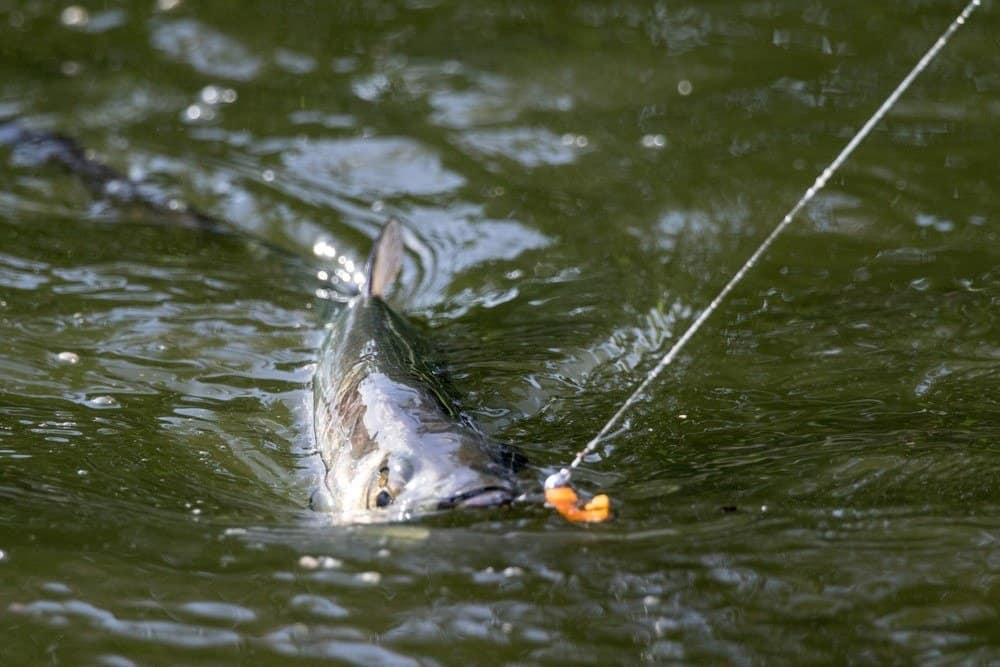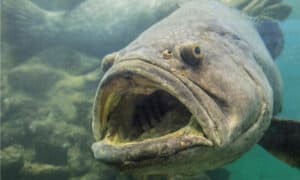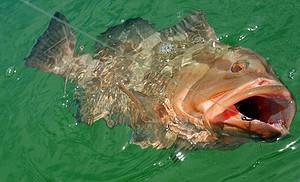Florida saltwater fishing is a very popular sport and hobby. There are many beaches and piers to choose from. You can even rent a boat and fish in the deep. One of the most common fish in Florida waters is the goliath grouper. But just how big do they get? Follow along to discover the largest goliath grouper ever caught in Florida.
About the Goliath Grouper
The first recorded goliath grouper, with its name, was in 1697. Its status is vulnerable and because of overfishing, they are highly susceptible to population decline.
Size and Description
Goliath grouper fish are very large. Some of the largest goliath groupers ever recorded reached 8.2 feet long. These massive fish can easily weigh over 300 pounds. Goliath groupers have brownish-yellow or grey and greenish skin with small black dots on their head, body, and fins. Interestingly, small goliath groupers less than 3.3 feet long have three to four faint vertical bars on each side. Goliath groupers aren’t known just for their massive size, but for their small eyes and flat heads.
Diet
Goliath groupers typically consume small fish and crustaceans. Some of the most consumed crustaceans are shrimp, spiny lobsters, and crabs. They also eat small and young sea turtles, stingrays, octopuses, and parrotfish. Goliath groupers are ambush predators. They swallow their prey whole without chewing.
Predators
Atlantic goliath grouper predators are large fish with few predators. However, young goliath predators are vulnerable to large fish and animals like moray eels, hammerhead sharks, king mackerels, and barracudas. When threatened, Atlantic goliath groupers make loud rumbling noises and open their mouths aggressively.
The Largest Goliath Grouper Ever Caught in Florida
On May 20, 1961, Lynn Joyner caught the largest goliath grouper ever in Florida. It weighed about 680 pounds and was caught in Fernandina Beach. Lynn used Spanish mackerel as fishing bait. For over five decades, the record for the largest goliath grouper ever caught in Florida has remained the same. This impressive catch is also an IGFA world record for the largest grouper ever caught.
Other Common Fish in Florida
Florida is filled with freshwater and saltwater fish. It’s a popular destination for anglers that love challenging fish. Some of the largest and most impressive fish in the world were caught in Florida waters. Follow along to learn more about some of the most common fish in Florida.
Brown Bullhead
The brown bullhead is a fish found all throughout North America, especially in the United States. Brown bullheads typically reach 21 inches long, but larger bullheads have been recorded. These large fish have brown and dark green skin with off-white or cream bellies. Brown bullheads are native to the Atlantic and Gulf Slope drainages, including the Great Lakes, the Mississippi River, and Hudson Bay. They are opportunistic bottom feeders mainly consuming leeches, insects, and plants.

Brown bullheads typically reach 21 inches long, but larger bullheads have been recorded.
©Brenda Miroslav/Shutterstock.com
Tarpon
Tarpons are large fish. There are two subspecies. One is native to the Atlantic, while the other is native to the Indo-Pacific Oceans. Tarpons live in saltwater, freshwater, and brackish waters. These fish are very adaptable and sometimes swim to the surface to take gulps of air. The gulps of air provide them with energy. Tarpons can grow anywhere from four to eight feet long and weigh about 60 to 280 pounds. On March 20, 2003, the largest recorded tarpon was caught by Max Domecq in Rubane, Guinea-Bissau, Africa. It weighed 286 pounds and 9 ounces.

Tarpons can grow anywhere from four to eight feet long and weigh about 60 to 280 pounds.
©wonderisland/Shutterstock.com
Spotted Sea Trout
Spotted seatrouts are dark grey or green, but they fade to a shimmering white or silver belly. These fish have many black spots on their backs that reach their tails. Spotted seatrouts are also called speckled seatrouts. They weigh about 17 pounds and measure 39 inches long. However, most spotted seatrout stop growing at 14 inches. These fish live in coastal waters. They prefer smooth sand bottoms and seagrass beds. Spotted seatrout live in deeper water during winter and consume a diet of shrimps, crabs, and smaller fish.
Summer Flounder
Summer flounders are common on the coast of Florida. They are one of the largest marine flatfish in the Atlantic Ocean. Summer flounders belong to the Paralichthys genus and the Paralichthyidae family. Summer flounders have about 5 to 14 eye-like spots across their bodies. They have a dark side which they can quickly change in color to blend with their surroundings. This is necessary when summer flounders burrow into the sand. Summer flounders can live up to 20 years. However, most males live 15 years, while females live about 17 years in the wild. Many people participate in recreational fishing for summer flounders and use different lures and baits while fishing from a pier or a drifting boat.

©iStock.com/Getty Images
Where is Fernandina Beach Located on a Map?
Situated in the northeastern region of Florida, Fernandina Beach serves as the county seat of Nassau County and is the northernmost city on the Atlantic coast of the state; located on Amelia Island, it also forms a significant part of Greater Jacksonville’s municipalities.
Here is Fernandina Beach on a map:
The photo featured at the top of this post is © Supermop/Shutterstock.com
Thank you for reading! Have some feedback for us? Contact the AZ Animals editorial team.






